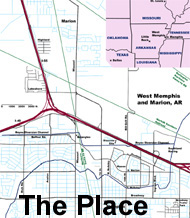
 |
 |
 |
 |
 |
 |
 |


The mtDNA sequence from the hair found beneath Moore's ligature.
|
Heteroplasmy and polymorphisms
None of the nuclear or mitochondrial DNA (mtDNA) evidence from the crime scene evidence matched the mtDNA of the convicted. In contrast, conclusions were drawn as to the potential source of two hairs. One hair from beneath the ligature of Michael Moore corresponded to mtDNA from cigarette butts taken from Terry Hobbs residence, and one hair found on a tree trunk corresponded to that of Hobbs' friend, David Jacoby. In each case the match was imperfect. Other imperfect matches call in to question the robustness of the findings. Mitochondrial DNA is handed down along the maternal family line. Like all DNA, it is a sequence of four chemicals in varying order. These chemicals called nucleotides can be thought of as the alphabet that makes up the instructions that define inherited traits. The four nucleotides are often referred to by the single letters of their initials, A, C, G and T. People differ from one another because of what these letters spell out. A difference in the DNA nucleotides between people at any given location is called a polymorphism, "poly" meaning "multiple," and "morphism" meaning "form." These polymorphisms are exploited to make a DNA fingerprint. For the analyses in this case, the sequences of the letters along two stretches of mtDNA were determined. These stretches are referred to as hypervariable regions one and two or, HV1 and HV2. The high rate of variability makes these areas prime targets for finding informative changes, significant polymorphisms that will then provide a distinct code that allows for comparisons between samples and the matching or exclusion of sources. Reports for mtDNA fingerprinting take the following format. The sequence of letters obtained are compared to a reference sequence, called the Anderson or Cambridge Reference Sequence (CRS, citation 1 below). Any variations from the CRS are listed. If there is no note made, it is assumed the nucleotides match with the CRS - and most of human DNA does match. Our mtDNA code, however, is not always perfectly consistent. Even within an individual, there can be slight variations of the sequence. A nucleotide change within an individual is called heteroplasmy. Heteroplasmy has been found in samples from approximately 11-12% of individuals (2-3). In this case, six hairs collected from the crime scene and morgue blankets did not match up with the victims' mtDNA. These were:
(source: Bode case report December 30, 2005, page 4)
Cigarettes, swabs and hairs The mtDNA from these anomalous hairs were compared to the mtDNA from the convicted and the mtDNA derived from at least two other individuals, Terry Hobbs, stepfather of victim, Steve Branch, and David Jacoby, friend of the Hobbs family. The samples representing Terry Hobbs were not provided voluntarily. The primary set used for comparison was derived from cigarette butts discarded in front of his house. Another sample was taken from a discarded Q-tip. The mtDNA sources for the Hobbs samples are described more completely below. During the presentation of the evidence at the defense team press conference, forensic serologist Thomas Fedor reported on the cigarette derived mtDNA: - [The results] Do not exclude the cigarette smoker as the source of a ligature hair on Moore.
- About 0.12% of the population could be the source of the cigarette butt DNA [taken from Hobbs house]. - About 1.5% of the population could be the source of the ligature hair [Defense team presentation, October 31, 2007] The match between the Hobbs cigarette samples and the hair from the ligature of Michael Moore was not perfect and heteroplasmy was suggested. There were four changes from the reference sequence that the cigarette mtDNA shared with the ligature hair. The cigarette mtDNA had one additional change. In other words, the cigarette mtDNA and the ligature hair had one difference. The reason was suggested to be heteroplasmy. The numbers below represent the nucleotide position and the letter represents the nucleotide polymorphism that varies from the CRS. The discrepant site between the two samples is italicized. 0140-03Aa (Moore ligature hair): 263 G, 309.1 C, 315.1 C and 16221 T
Cigarette butts from Hobbs home: 263 G, 309.1 C, 315.1 C, 16093 C and 16221 T [Bode Technology Group, Inc. Mitochondrial Forensic DNA Case Report, December 30, 2005 and, Serological Research Institute Third Analytical Report, May 11, 2007]
Terry Hobbs' friend, David Jacoby, willingly provided a cheek
swab sample which allowed for good test resolution. He was deemed to be
a potential source of the hair recovered from the tree trunk. There
were three changes from the reference sequence that the Jacoby mtDNA
shared with the tree trunk hair. Jacoby's mtDNA had one additional
change, meaning again, there was a single mismatch. Once more, the
reason was suggested to be heteroplasmy.
0140-23 (tree trunk hair): 263 G, 309.1 C and 315.1 C.
David Jacoby cheek swab: 152 C, 263 G, 309.1 C and 315.1 C. [Bode Technology Group, Inc. Mitochondrial Forensic DNA Case Report, December 30, 2005 and, Serological Research Institute Fifth Analytical Report, October 26, 2007] Was the mtDNA from the cigarette butts the mtDNA of Terry Hobbs? Three cigarette butts collected from in front of the home of Terry Hobbs were sequenced for mtDNA. After these were sequenced, a Q-tip was obtained. These four samples led to three different sets of results. Two of the cigarette butts, referred to as items 8 and 10, had matching mtDNA. The cigarette butt referred to as item 9 had eight sites that did not resolve into a single nucleotide. Furthermore, it had two nucleotide differences from items 8 and 10. The report concluded the "DNA recovered from item 9 is a mixture from more than one person, neither of whom belong(s) to the same maternal line as the person(s) represented by items 8 and 10." [Serological Research Institute Third Analytical Report, May 11, 2007] If items 8 and 10 represented Terry Hobbs mtDNA, then 9 did not. The Q-tip (item 14) from the Terry Hobbs residence had mtDNA differences at four sites when compared to the Hobbs cigarette mtDNA on items 8 and 10. Furthermore, a single nucleotide could not be resolved at six sites. This is both indicative of different sources for the items 8, 9, and 10 versus the Q-tip and a poor resolution for the test, probably because of a mtDNA mixture, at least two persons using the Q-tip. The SRI report concluded that "item 14 is unsuitable for comparison to the hairs analyzed at Bode..." [Serological Research Institute Fifth Analytical Report, October 26, 2007] Summary of Hobbs' items: Terry Hobbs cigarettes, item 8 and 10: 263 G, 309.1 C, 315.1 C, 16093 C and 16221 T
Terry Hobbs cigarette, item 9: 73 R, 153 R, 195 Y, 226 Y, 263 G, 309.1 C, 315.1 C. HV1 reported with Y at 16223 and 16278 and R at 16129 and 16316. Terry Hobbs Q-tip (item 14): HV2 reported as 73 G, 152 C, 263 G, 309.1 C and 315.1 C. HV1 reported with Y at positions 16069, 16167, 16231, 16261, 16294 and 16304. [sources: Serological Research Institute Third Analytical Report, May 11, 2007 and Fifth Analytical Report, October 26, 2007] The conclusion that the mtDNA from items 8 and 10 belongs to Terry Hobbs is inferential. A more definitive sample collection would produce a definitive result. Did the mtDNA from the Hobbs cigarette (items 8 and 10) match the hair at the crime scene? The allowance for heteroplasmy is troubling. If it is indeed found in 11-12% of samples, to be found twice in the two key comparisons is unlikely. In a recent study by Paneto, et al., entitled Heteroplasmy in hair: differences among hair and blood from the same individuals are still a matter of debate, they conclude "One difference between two samples supposed to be originated from the same individual are related to an inconclusive result, but depending on the tissue and the position of the difference it should have a different interpretation, based on mutation-rate heterogeneity of mtDNA. (3)" Furthermore, by the standards of allowing one site change we have further near matches. Other single mismatches There were six anomalous hair samples collected from the crime scene, i.e., hairs that did not match the victims. Of these six, the one from the cub scout cap had successful sequencing in only one hypervariable region. This stretch of mtDNA had three nearly unique nucleotide mismatches and it was at least three nucleotides distant from any other sample. The "Negroid" hair had twelve unique nucleotide mismatches making it at least twelve steps distant from any other sample. The hair from beneath Chris Byers ligature was at least seven nucleotides distant from any other sample. The remaining three hairs were remarkably similar. The tree trunk hair is a single nucleotide different from the Moore ligature hair. 0140-23 (tree trunk hair): 263 G, 309.1 C and 315.1 C.
0140-03Aa (Moore ligature hair): 263 G, 309.1 C, 315.1 C and 16221 T [Bode case report December 30, 2005] The tree trunk hair is also a single nucleotide different from the dyed hair. 0140-27 (dyed hair from sheet covering Branch): 263 G, 309.1 C, 315.1 C and 16261 T.
0140-23 (tree trunk hair): 263 G, 309.1 C and 315.1 C. [Bode case report December 30, 2005] There are two possible explanations for this. One is that multiple sources with very similar mtDNA left their hairs at the crime scenes. This is highly improbable. The other is that these were from the same source, either due to heteroplasmy or due to imprecision in the test. There is one other surprising pair of similarities among the samples. David Jacoby is a single nucleotide distant from Damien Echols. David Jacoby: 152 C, 263 G, 309.1 C, and 315.1 C.
Damien Echols: 152 C, 263 G, 309.1 C, 315.1 C and 16239 G. [Bode case report Jan. 25, 2007, and Serological Research Institute Fifth Analytical Report, October 26, 2007] Conclusions The 1 in 100 odds of the (imperfect) match between the cigarettes from Hobbs house and the mtDNA from Moore's ligature is less compelling in light of these other near matches. The presence of so many closely related samples calls in to question the quality of the testing. The near matching samples between Jacoby and Echols might be a result of what is referred to in statistics as the "birthday problem" combined with a somewhat homogeneous genetic pool in this area. In contrast, the near matches among three of the anomalous hairs from the crime scene point to one source for these three hairs. If the DNA match between Hobbs and the ligature hair is valid, does that 1 in a 100 odds provide good evidence of guilt? The lawyerly argument of "There are 12,000 people in the metro area that could match that" is not a strong probablistic argument. The coincidental matching of any given suspect is still 1 in a 100 - much stronger than most evidence. Eyewitness identification is much less conclusive and more prone to error. The mtDNA results from the Hobbs house cigarettes seemed to have initiated a more intense scrutiny of Hobbs as a suspect. Before the May 11, 2007 report of the findings there was only general notes regarding his actions searching for the missing children. So then, why was the mtDNA of Hobbs sought for sequencing? Perhaps a vital clue resides in a note introducing the Third Analytical Report from Serological Research Institute. This mentions other items, one through seven, having been sequenced mentioned in reports not presented as attachments to the legal motion. The reason for the lack of attachment is probably that the results showed no significant relation to the crime scene samples. I propose the investigation strategy was this: obtain DNA sequences from JM Byers, Todd Moore and Terry Hobbs for exclusionary purposes. The previous items were probably from Todd Moore and JM Byers. Other family members would not be necessary for exclusion. The mothers and their children would have the same mtDNA as the victims. In my previous writings I have been in error in looking at the general strength of mtDNA evidence while not carefully appraising this particular evidence. The court filings include the raw data for close examination. Mitochondrial DNA fingerprinting is a powerful tool. In this case, however, the conclusions that can be drawn from these data have been weakened by three factors. First, the presence of a single nucleotide heteroplasmy prevents samples from being described as matching. At best, it can be said that a source can not be excluded. Single nucleotide heteroplasmy also allows for a variety of other near matches. Second, the presence of two hairs gathered from the crime scene that are one nucleotide distant from the tree trunk hair strongly indicates an imperfect sequence determination. The most likely explanation is that the hair beneath Michael Moore's ligature, the tree trunk hair and the dyed hair on the morgue blanket are from the same source. Finally, the cigarettes are only inferentially connected to Terry Hobbs - although this weakness could be corrected with a better collected sample. Further technical considerations regarding heteroplasmy The above discussion is somewhat simplified. The rate at which heteroplasmy appears is a matter of debate. Some researchers have found a higher rate and even multiple heteroplasmy within samples. There are several reasons to believe the rate is approximately 10%. Papers citing a very high rate and multiple changes have probably reported artifacts involving the high numbers of DNA copy cycles. Another confounding factor is that heteroplasmy can mean a variance in length of the mtDNA segment or point mutations. In a recent study by Santos et al., these researchers found length heteroplasmy occurred frequently among samples from 210 unrelated individuals. Point heteroplasmy occurred in only 3.8% of individuals (Santos, et al., 2008, J Mol Evol. 67:191-200). Each of the six of the putative heteroplasmy sites separating the individuals with one nucleotide distance was point heteroplasmy. Not all polymorphism changes are equal. Site changes from C to T (or T to C) and A to G (or G to A) are much more common than other changes. These changes are called transitions. All of the single nucleotide differences were transitions. Heteroplasmy usually presents itself as multiple nucleotides being present at a specific site. In each of the six samples with one nucleotide difference a single nucleotide appeared. While this is possible, it is a less likely outcome. The rate of heteroplasmy varies according to several factors including tissue source, advanced age and smoking. The 11-12% rates cited above refer to hair mtDNA. Buccal swabs may have a higher rate and would be relevant to the Jacoby sample. Smokers have been shown to have a higher rate of heteroplasmy in buccal swab samples - although it is more likely that smoke changes the mtDNA of buccal tissues than it would hair. (1) Anderson
S, Bankier AT, Barrell BG, de Bruijn MH, Coulson AR, Drouin J, Eperon
IC, Nierlich DP, Roe BA, Sanger F, Schreier PH, Smith AJ, Staden R,
Young IG. (1981) Sequence and organization of the human mitochondrial
genome. Nature. 290:457-65 (sequence updated 1999)
(2) Paneto GG, Martins JA, Longo LV, Pereira GA, Freschi A, Alvarenga VL, Chen B, Oliveira RN, Hirata MH, Cicarelli RM. (2007) Heteroplasmy in hair: differences among hair and blood from the same individuals are still a matter of debate. Forensic Sci Int. 173:117-21. (3) Calloway CD, Reynolds RL, Herrin GL Jr, Anderson WW. (2000) The frequency of heteroplasmy in the HVII region of mtDNA differs across tissue types and increases with age. Am J Hum Genet. 66:1384-97 (4) Santos C, Sierra B, Alvarez L, Ramos A, Fernández E, Nogués R, Aluja MP. (2008) Frequency and pattern of heteroplasmy in the control region of human mitochondrial DNA. J Mol Evol. 67:191-200. |
mtDNA
|
|
Chris Byers |
Steve Branch |
|
David Jacoby |
D Echols |
J Misskelley |
J Baldwin |
hair, Moore
ligature
|
hair, Byers,
ligature
|
hair,
|
Dyed hair,
white sheet
|
Negroid
hair
|
M Moore |
- |
12 |
12 |
11 |
9 |
10 |
11 |
12 |
11 |
15 |
10 |
11 |
24 |
C Byers |
|
- |
12 |
12 |
11 |
12 |
10 |
10 |
11 |
13 |
10 |
9 |
24 |
Branch |
|
|
- |
16 |
13 |
14 |
15 |
15 |
15 |
19 |
14 |
13 |
28 |
Hobbs cigarette |
|
|
- |
3 |
4 |
5 |
4 |
1 |
7 |
2 |
3 |
20 |
|
Jacoby |
|
|
|
|
- |
1 |
4 |
3 |
2 |
8 |
1 |
2 |
17 |
Echols |
|
|
|
|
|
- |
5 |
4 |
3 |
9 |
2 |
3 |
18 |
Misskelley |
|
|
|
|
|
|
- |
5 |
4 |
4 |
3 |
4 |
19 |
Baldwin |
|
|
|
|
|
|
|
- |
3 |
7 |
2 |
3 |
18 |
114-03Aa, Moore ligature |
|
|
|
|
|
|
- |
8 |
1 |
2 |
19 |
||
114-15, Byers ligature |
|
|
|
|
|
|
|
- |
7 |
8 |
21 |
||
114-23, tree trunk |
|
|
|
|
|
|
|
|
- |
1 |
18 |
||
114-27, dyed hair, white sheet |
|
|
|
|
|
|
|
|
|
- |
19 |
||

| Copyright © 2008 Martin David Hill |
| Site Design By Michael Gillen |